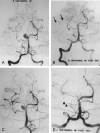Thromboembolic events associated with balloon-assisted coil embolization: evaluation with diffusion-weighted MR imaging
- PMID: 15569744
- PMCID: PMC8148712
Thromboembolic events associated with balloon-assisted coil embolization: evaluation with diffusion-weighted MR imaging
Abstract
Background and purpose: Thromboembolic events may occur during or after the treatment of intracranial aneurysms with Guglielmi detachable coils (GDCs). The purpose of this study was to determine the frequency of thromboembolic events associated with balloon-assisted coil placement and to investigate possible risk factors for these events during balloon-assisted coil placement and embolization.
Methods: Twenty patients with cerebral aneurysms treated with balloon-assisted coil placement and embolization at our institution were included. All patients underwent diffusion-weighted (DW) imaging within 6 hours after the procedure. Two neuroradiologists reviewed all DW images to detect ischemic lesions.
Results: Hyperintense lesions compatible with thromboembolic events were detected on DW images of four (20%) patients. Three lesions were in the territory of posterior circulation, and one was in the territory of anterior circulation. The occurrence of new lesions was strongly associated with the number of times the microcatheter or coil was repositioned and removed and with the size of the aneurysmal neck (P < .01). DW imaging findings did not suggest a strong correlation between the occurrence of new ischemic lesions and potential risk factors (maximum balloon inflation time, number of times the balloon was inflated, etc.) associated with balloon-assisted coil placement and embolization (P > .05).
Conclusion: The risk of thromboembolic events during the treatment of intracranial aneurysms with balloon-assisted techniques is not more significant than when conventional GDC techniques are used. The only variables found to influence this risk during or after balloon-assisted coil placement were microcatheter repositioning, coil removal and repositioning, and size of the aneurysmal neck.
Figures


Similar articles
-
Thromboembolic events associated with Guglielmi detachable coil embolization of asymptomatic cerebral aneurysms: evaluation of 66 consecutive cases with use of diffusion-weighted MR imaging.AJNR Am J Neuroradiol. 2003 Jan;24(1):127-32. AJNR Am J Neuroradiol. 2003. PMID: 12533341 Free PMC article.
-
Thromboembolic events associated with Guglielmi detachable coil embolization with use of diffusion-weighted MR imaging. Part II. Detection of the microemboli proximal to cerebral aneurysm.AJNR Am J Neuroradiol. 2003 Nov-Dec;24(10):2035-8. AJNR Am J Neuroradiol. 2003. PMID: 14625228 Free PMC article.
-
Thromboembolic events associated with single balloon-, double balloon-, and stent-assisted coil embolization of asymptomatic unruptured cerebral aneurysms: evaluation with diffusion-weighted MR imaging.Neuroradiology. 2014 Dec;56(12):1079-86. doi: 10.1007/s00234-014-1421-4. Epub 2014 Sep 4. Neuroradiology. 2014. PMID: 25185529
-
Endovascular treatment of intracranial aneurysms with Guglielmi Detachable Coils: emphasis on new techniques.J Clin Neurosci. 2000 May;7(3):244-53. doi: 10.1054/jocn.1999.0211. J Clin Neurosci. 2000. PMID: 10833624 Review.
-
Intravascular stent and endovascular coil placement for a ruptured fusiform aneurysm of the basilar artery. Case report and review of the literature.J Neurosurg. 1997 Dec;87(6):944-9. doi: 10.3171/jns.1997.87.6.0944. J Neurosurg. 1997. PMID: 9384409 Review.
Cited by
-
Contrast enhancement hyperdensity after endovascular coiling of intracranial aneurysms.AJNR Am J Neuroradiol. 2008 Mar;29(3):588-93. doi: 10.3174/ajnr.A0844. Epub 2007 Nov 26. AJNR Am J Neuroradiol. 2008. PMID: 18039758 Free PMC article.
-
Thromboembolic event detected by diffusion weighted magnetic resonance imaging after coil embolization of cerebral aneurysms.J Cerebrovasc Endovasc Neurosurg. 2014 Sep;16(3):175-83. doi: 10.7461/jcen.2014.16.3.175. Epub 2014 Sep 30. J Cerebrovasc Endovasc Neurosurg. 2014. PMID: 25340018 Free PMC article.
-
Double-balloon remodeling of wide-necked aneurysms distal to the circle of Willis.AJNR Am J Neuroradiol. 2005 Aug;26(7):1768-71. AJNR Am J Neuroradiol. 2005. PMID: 16091528 Free PMC article.
-
Double-balloon Trapping for Coil Embolization of Ruptured Internal Carotid Artery Aneurysm: A Novel Technique.Asian J Neurosurg. 2019 Jul-Sep;14(3):873-877. doi: 10.4103/ajns.AJNS_134_17. Asian J Neurosurg. 2019. PMID: 31497117 Free PMC article.
-
Thromboembolic Events Associated with Electrolytic Detachment of Guglielmi Detachable Coils and Target Coils : Comparison with Use of Diffusion-Weighted MR Imaging.J Korean Neurosurg Soc. 2013 Jul;54(1):19-24. doi: 10.3340/jkns.2013.54.1.19. Epub 2013 Jul 31. J Korean Neurosurg Soc. 2013. PMID: 24044075 Free PMC article.
References
-
- Guglielmi G, Vinuela F, Sepetka I, Macellari V. Electrothrombosis of saccular aneurysms via endovascular approach, I: electrochemical basis, technique and experimental results. J Neurosurg 1991;75:1–7 - PubMed
-
- Guglielmi G, Vinuela F, Sepetka I, Macellari V. Electrothrombosis of saccular aneurysms via endovascular approach, 2: preliminary clinical experience. J Neurosurg 1991;75:8–14 - PubMed
-
- Nichols DA, Meyer FB, Piepgras DG, Smith PL. Endovascular treatment of intracranial aneurysms: subject review. Mayo Clin Proc 1994;69:272–285 - PubMed
-
- Moret J, Cognard C, Weill A, Castaings L, Rey A. The “remodeling technique” in the treatment of wide neck intracranial aneurysms: Angiographic results and clinical follow-up in 56 cases. Intervent Neuroradiol 1997;3:21–35 - PubMed
Publication types
MeSH terms
LinkOut - more resources
Full Text Sources
Medical
